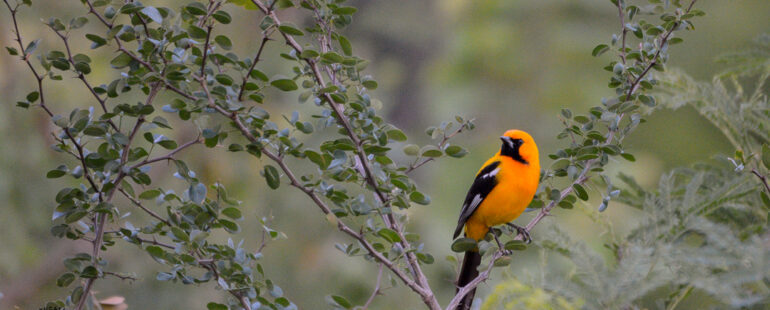Three and a Half Day Birding Tour February 2025
This birding tour was designed for John and Rose, visitors from Alberta, Canada. We based this tour on a previous tour that they saw and liked on our birding blog.
DAY 1: THE MÉRIDA AREA.
Starting in Mérida the capital of the Yucatán state, I picked up John and Rose at 6 AM for a very short drive to our first birding location. The Misnebalam Road, many times mentioned in this blog and one of our favorite birding locations. The start of the trip was as good as it could, with the first bird of the trip being the legendary (at least for the maya and Yucatan people) Turquoise-browed Motmot (also known as “Toh”). Our total number of species observed for the first stop was 50 with our highlights including: Groove-billed Ani, Ruby-throated Hummingbird, Cinnamon Hummingbird, Ferruginous Pygmy-Owl, Turquoise-browed Motmot, Yucatan Woodpecker, Golden-fronted Woodpecker, American Kestrel, White-fronted Amazon, Brown-crested Flycatcher, Boat-billed Flycatcher, Couch’s Kingbird, Yellow-throated Vireo, Yucatan Jay, Gray Catbird, Clay-colored Thrush, Hooded Oriole, Orange Oriole, Altamira Oriole, Baltimore Oriole, Bronzed Cowbird, Summer Tanager, Northern Cardinal, Blue Grosbeak, Indigo Bunting, Painted Bunting and Cinnamon-bellied Saltator.
After that, we drove for another 15 minutes to the coast in Progreso, to a road that crosses a big estuary with mangroves so we could pick up some of the aquatic birds of the area. Highlights from our visit to the coast include: Blue-winged Teal, Mangrove Cuckoo, Black-necked Stilt, American Avocet, Black-bellied Plover, Semipalmated Plover, Spotted Sandpiper, Willet, Greater Yellowlegs, Ruddy Turnstone, Least Sandpiper, Western Sandpiper, Laughing Gull, Black Skimmer, Caspian Tern, Sandwich Tern, Royal Tern, American Flamingo, Neotropic Cormorant, White Ibis, Black-crowned Night Heron, Little Blue Heron, Tricolored Heron, Reddish Egret, Snowy Egret, Green Heron, Great Egret, Great Blue Heron, American White Pelican, Brown Pelican, Black Vulture, Olive-throated Parakeet and Red-winged Blackbird.
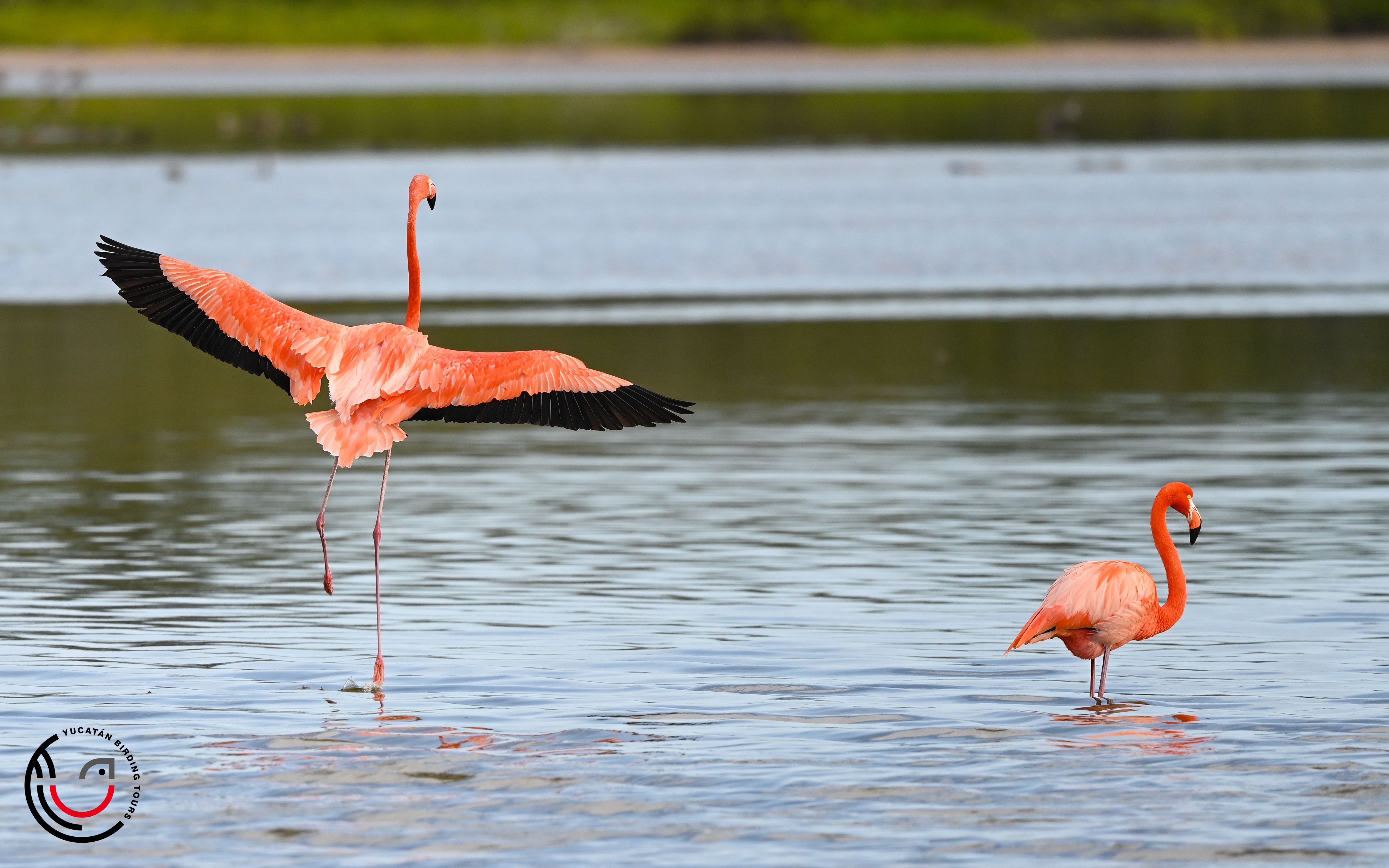
American Flamingos (Phoenicopterus ruber) in Progreso.
We finished up the morning visiting an ecological park in Mérida that had been pretty good for birding lately, as the ceiba trees were flowering and warblers were going crazy! Top birds included: Northern Potoo, Cinnamon Hummingbird, Black Vulture, Yucatan Jay, Cave Swallow, Orchard Oriole, Hooded Oriole, Melodious Blackbird, Tennessee Warbler, Northern Parula and Yellow-rumped Warbler.
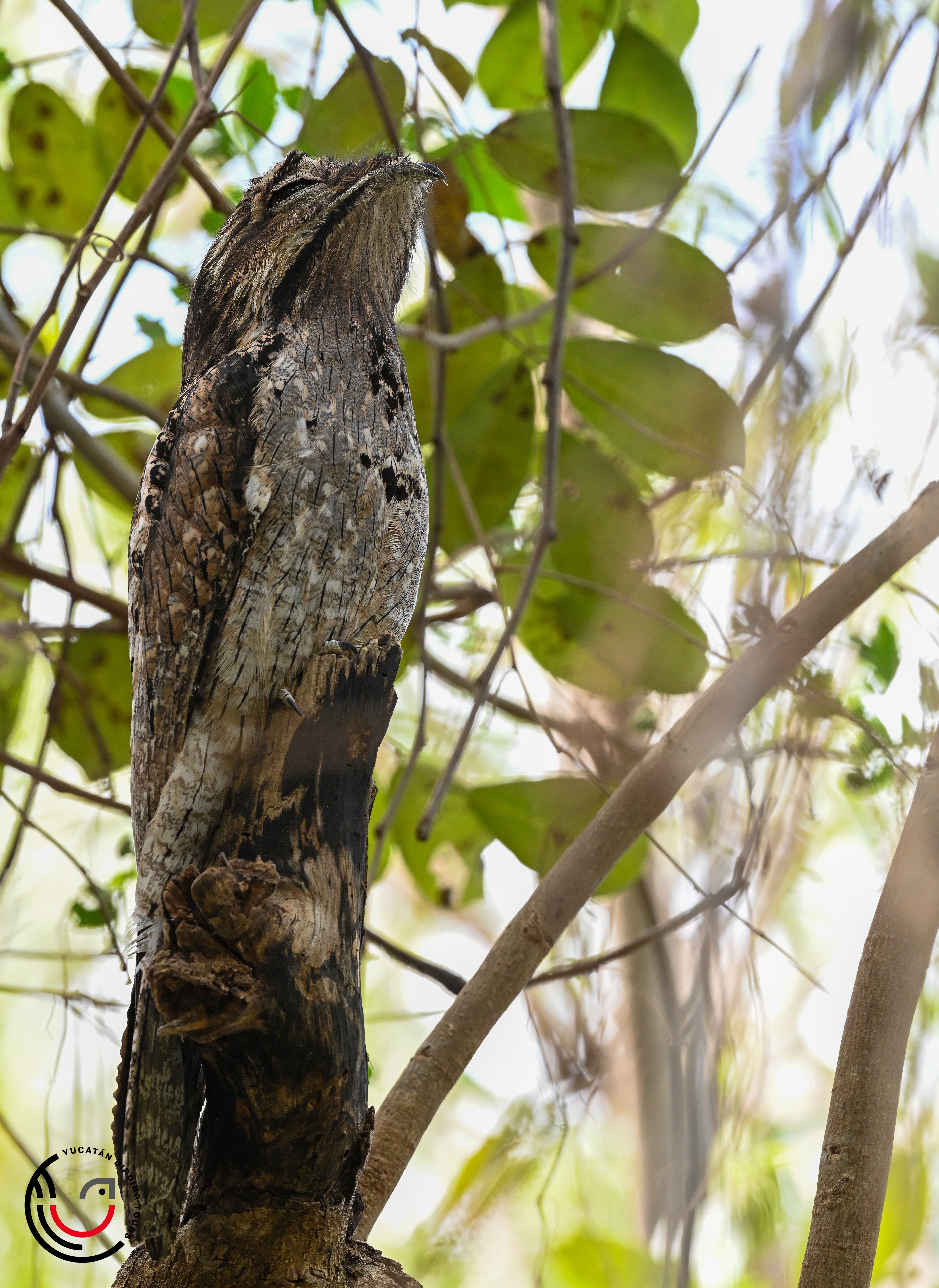
Northern Potoo (Nyctibius jamaicensis) in an ecological park in Mérida.
After birding, we went to a Yucatecan restaurant for lunch. We had “Huevos Motuleños” one of the most popular Yucatecan dishes. Then, we rested the hottest part of the day and I picked up John and Rose again in the evening for some more birding. This time we went to Acuaparque, one of the most (if not the most) popular ecological parks in Mérida. There, in about an hour of birding we spotted 34 species including: Lesser Scaup, Ruby-throated Hummingbird, Common Gallinule, American Coot, Northern Jacana, Solitary Sandpiper, Least Grebe, Pied-billed Grebe, Anhinga, Neotropic Cormorant, Tricolored Heron, Snowy Egret, Green Heron, Great Egret, Black Vulture, Peregrine Falcon, Tropical Kingbird, Clay-colored Thrush, Altamira Oriole and Summer Tanager.
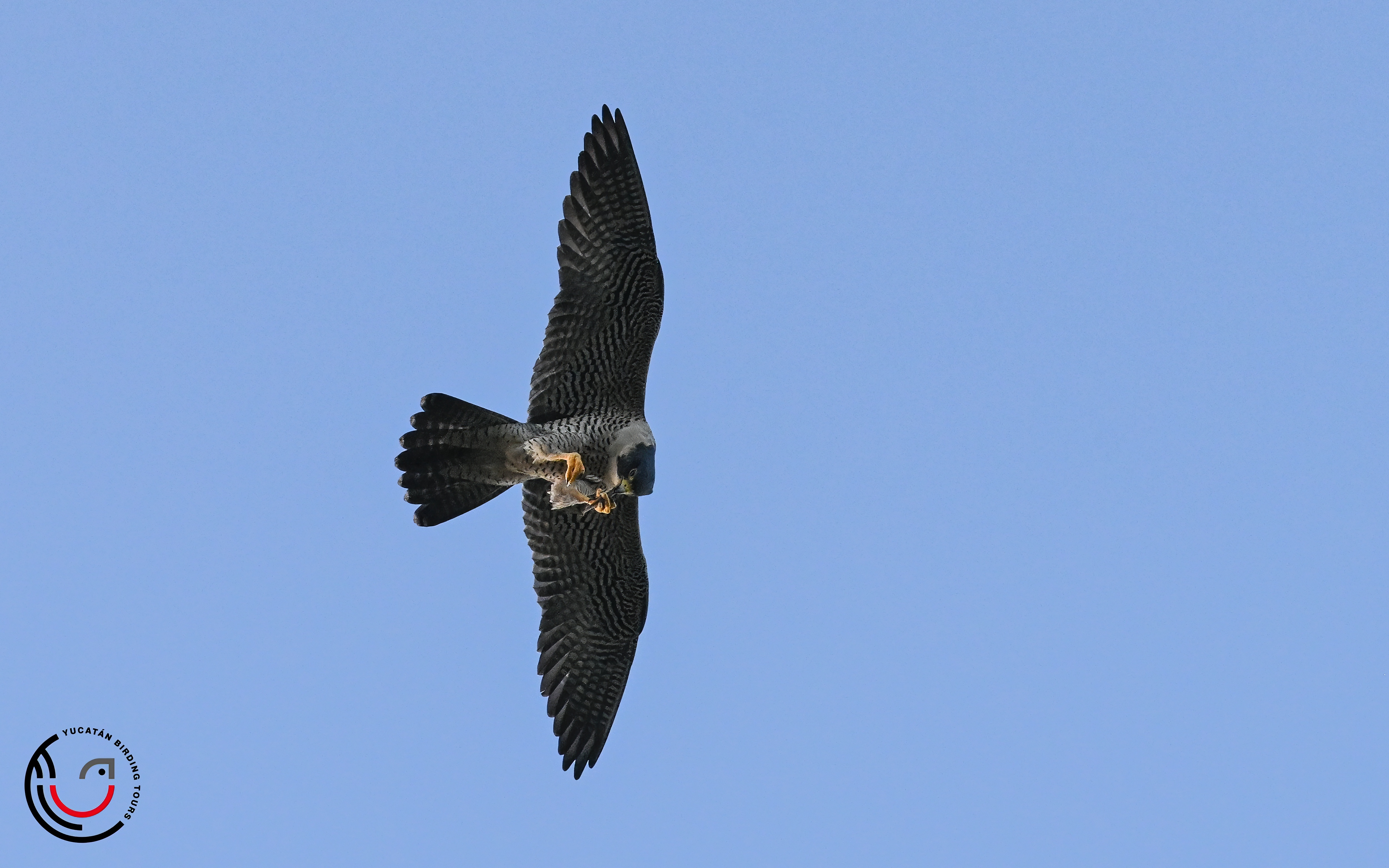
Peregrine Falcon (Falco peregrinus) eating a grasshoper in flight.
Great-tailed Grackles are usually not included in the highlights as these birds are absolutely everywhere, but this time, there was a huge locust swarm in Mérida and watching the grackles go for them in flight was quite a spectacle.

Great-tailed Grackles (Quiscalus mexicanus) chasing grasshopers.
DAY 2: MÉRIDA AND VALLADOLID.
For day two, we planned on looking for the endemic birds of the northern coast of the Yucatan before heading to Valladolid. So, we headed northwest of Mérida towards Chuburná. In less than an hour birding the coastal dunes near the beach, we spotted the three endemics of the coast plus some other cool birds. Highlights included: Common Ground Dove, Zenaida Dove, Mexican Sheartail, Black-bellied Plover, Spotted Sandpiper, Sanderling, Laughing Gull, Sandwich Tern, Magnificent Frigatebird, Double-crested Cormorant, Brown Pelican, Yucatan Gnatcatcher, Yucatan Wren, Savannah Sparrow, Hooded Oriole, Yellow Warbler, Palm Warbler, Northern Cardinal and Painted Bunting.
Since we got the endemics pretty quickly, we went to an area with a big mudflat to look for more shorebirds, terns and gulls. We spotted quite a flock with more or less, 630 individuals, including: American Avocet, Semipalmated Plover, Greater Yellowlegs, Ruddy Turnstone, Red Knot, Western Sandpiper, Least Sandpiper, Laughing Gull, Black Skimmer, Forster’s Tern, Common Tern, Caspian Tern, Sandwich Tern, White Ibis, Tricolored Heron, Reddish Egret, Snowy Egret, Gren Heron, Great Egret, Great Blue Heron, Belted Kingfisher, American White Pelican and Brown Pelican.
On the road back to Mérida, we also spotted a Russet-naped Wood-Rail, Turkey Vulture and Lesser Yellow-headed Vulture.
We drove to Valladolid, checked in at our hotel, dropped our stuff and got ready to go out birding again. This time, to bird near the Amazili Nature Reserve where we birded until it got dark. In about 2 hours, we spotted 40+ bird species. Highlights included: Red-billed Pigeon, Groove-billed Ani, Vaux’s Swift, Canivet’s Emerald, Roadside Hawk, Yucatan Woodpecker, Golden-fronted Woodpecker, Lineated Woodpecker, White-fronted Amazon, Yellow-lored Amazon, Boat-billed Flycatcher, Couch’s Kingbird, Yucatan Jay, Cave Swallow, Blue-gray Gnatcatcher, Carolina Wren, White-bellied Wren, Orange Oriole, Melodious Blackbird, Tennessee Warbler, Magnolia Warbler, Northern Cardinal, Rose-breasted Grosbeak and Indigo Bunting.
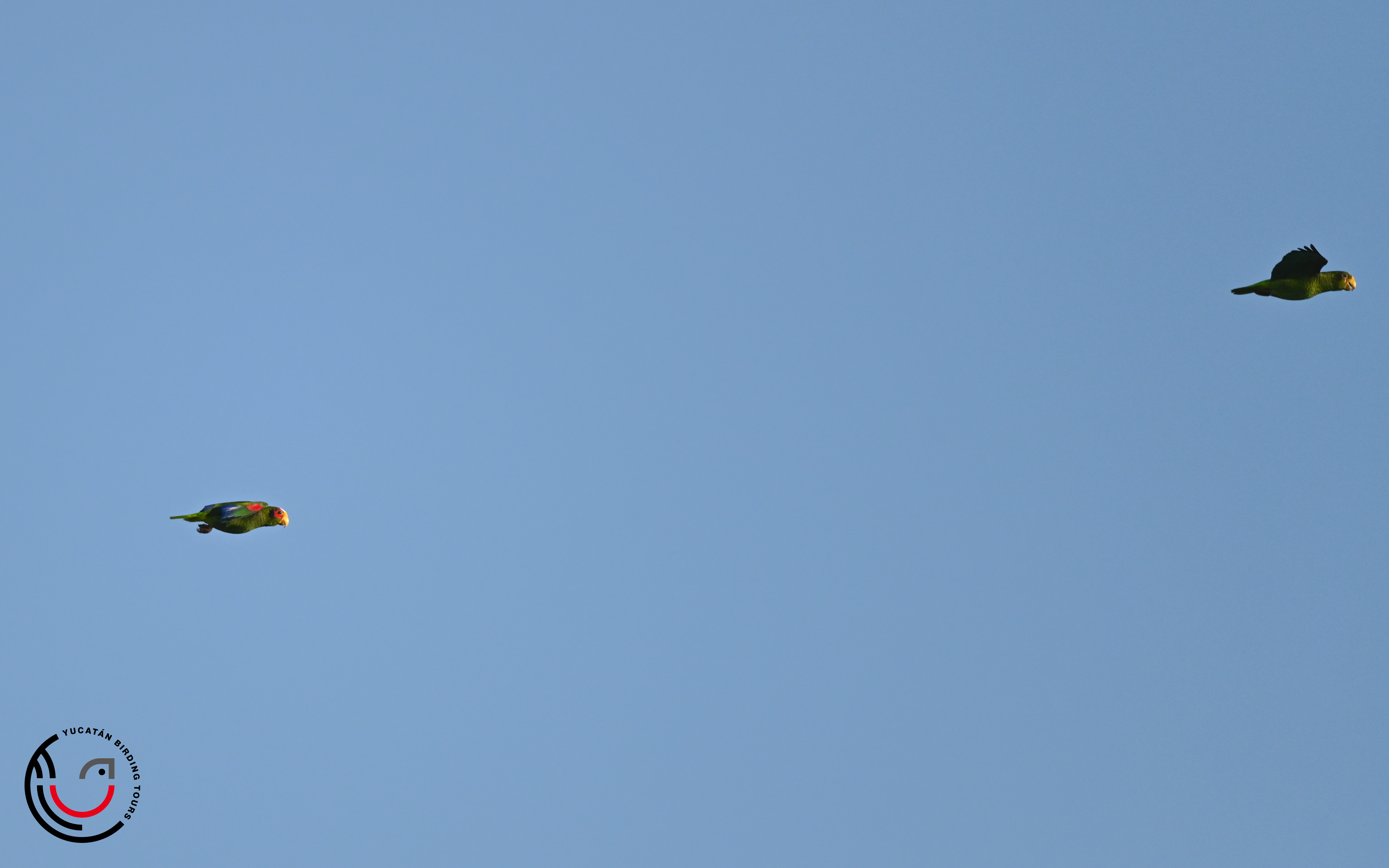
Yellow-lored Amazon (Amazona xantholora).
After birding, we went back to Valladolid for dinner and to rest as the next morning, we would have to leave very early to get to our next birding spot at dawn.
DAY 3: FELIPE CARRILLO PUERTO AND BACALAR.
For our third day, we left Valladolid at 4 AM so we could visit the “Siijil Noh Ha” reserve near Felipe Carrillo Puerto. This area has the combination of the semievergreen forest and a big water body, great for birds and definitely one of our favorite birding destinations in the Yucatan Peninsula.
We walked the first part of the trail for about hour and a half and spotted 50+ birds, including: Scaled Pigeon, Squirrel Cuckoo, Buff-bellied Hummingbird, Roadside Hawk, Black-headed Trogon, Gartered Trogon, Turquoise-browed Motmot, White-necked Puffbird, Collared Aracari, Keel-billed Toucan, Pale-billed Woodpecker, White-crowned Parrot, White-fronted Amazon, Yellow-lored Amazon, Olive-throated Parakeet, Masked Tityra, Rose-throated Becard, Yellow-olive Flatbill, Northern Beardless-Tyrannulet, Yucatan Flycatcher, Dusky-capped Flycatcher, Social Flycatcher, Lesser Greenlet, Yellow-throated Vireo, Brown Jay, Gray-breasted Martin, White-browed Gnatcatcher, Spot-breasted Wren, Scrub Euphonia, Yellow-throated Euphonia, Black-cowled Oriole, Orange Oriole, Black-and-white Warbler, Hooded Warbler, Magnolia Warbler and Indigo Bunting.
Then, we drove all the way to the reserve right next to the water and the cenotes, paid our entrance fees and birded for another two hours. Highlights included: White-tipped Dove, Black Hawk-Eagle, Short-tailed Hawk, Black-headed Trogon, Gartered Trogon, Turquoise-browed Motmot, Golden-fronted Woodpecker, Golden-olive Woodpecker, Olive-throated Parakeet, Black-crowed Tityra, Masked Tityra, Tropical Royal Flycatcher, Yellow-olive Flatbill, Greenish Elaenia, Northern Tropical Pewee, Least Flycatcher, Boat-billed Flycatcher, Lesser Greenlet, Mangrove Vireo, Mangrove Swallow, Northern Rough-winged Swallow, Scrub Euphonia, Yellow-throated Euphonia, Black-cowled Oriole, Hooded Oriole, Altamira Oriole, Melodious Blackbird, Hooded Warbler, American Redstart, Northern Parula, Magnolia Warbler, Yellow Warbler, Palm Warbler, Red-crowned Ant-Tanager and Morelet’s Seedeater.
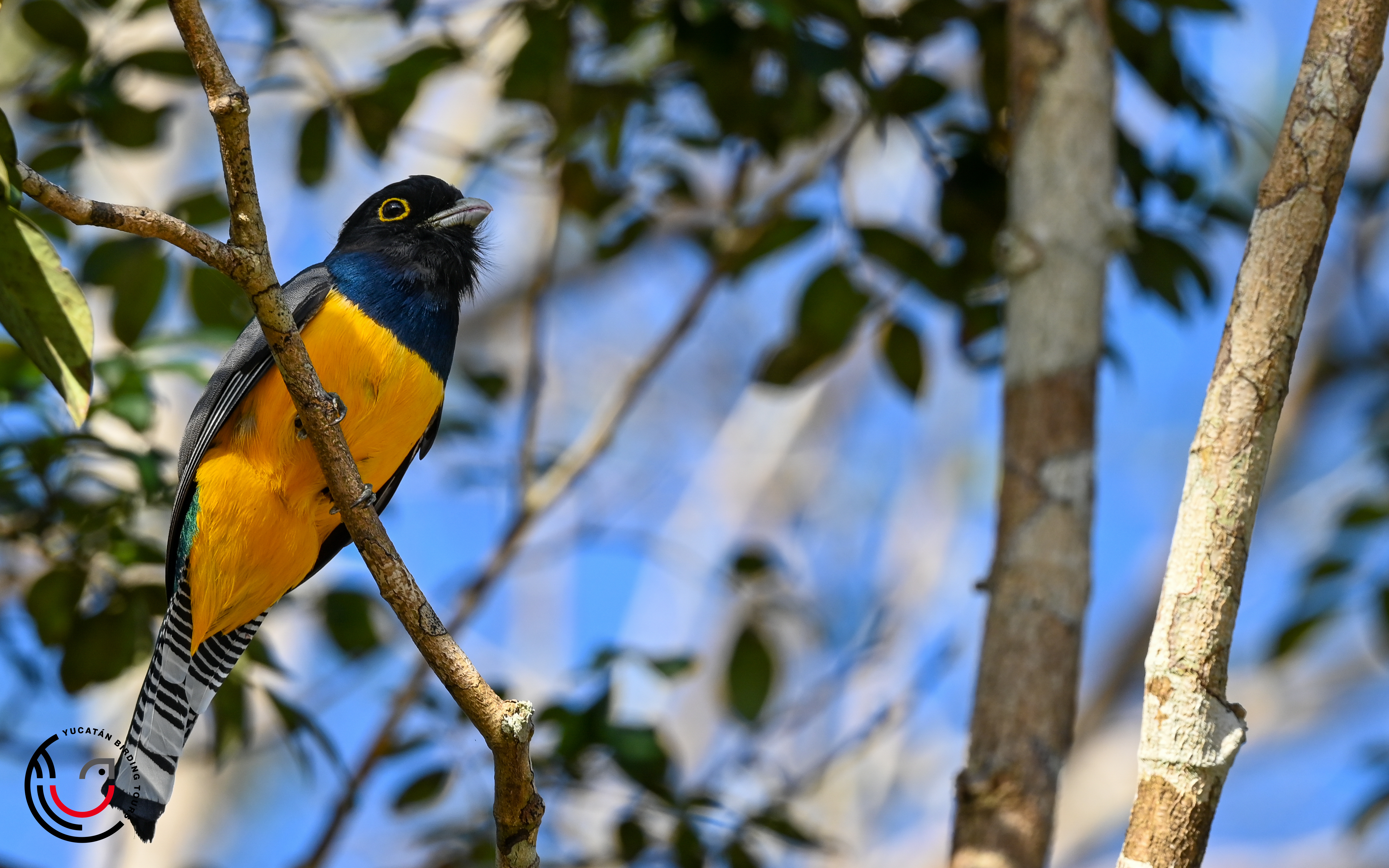
Gartered Trogon (Trogon caligatus) at the Siijil Noh Ha reserve.
We left the reserve and on the way to lunch, we spotted a big kettle of Black Vultures and Turkey Vultures. I knew that this was a good area for a very special bird. So as we were driving by, I spotted the big black and white bird soaring very low, an absolutely beautiful King Vulture!
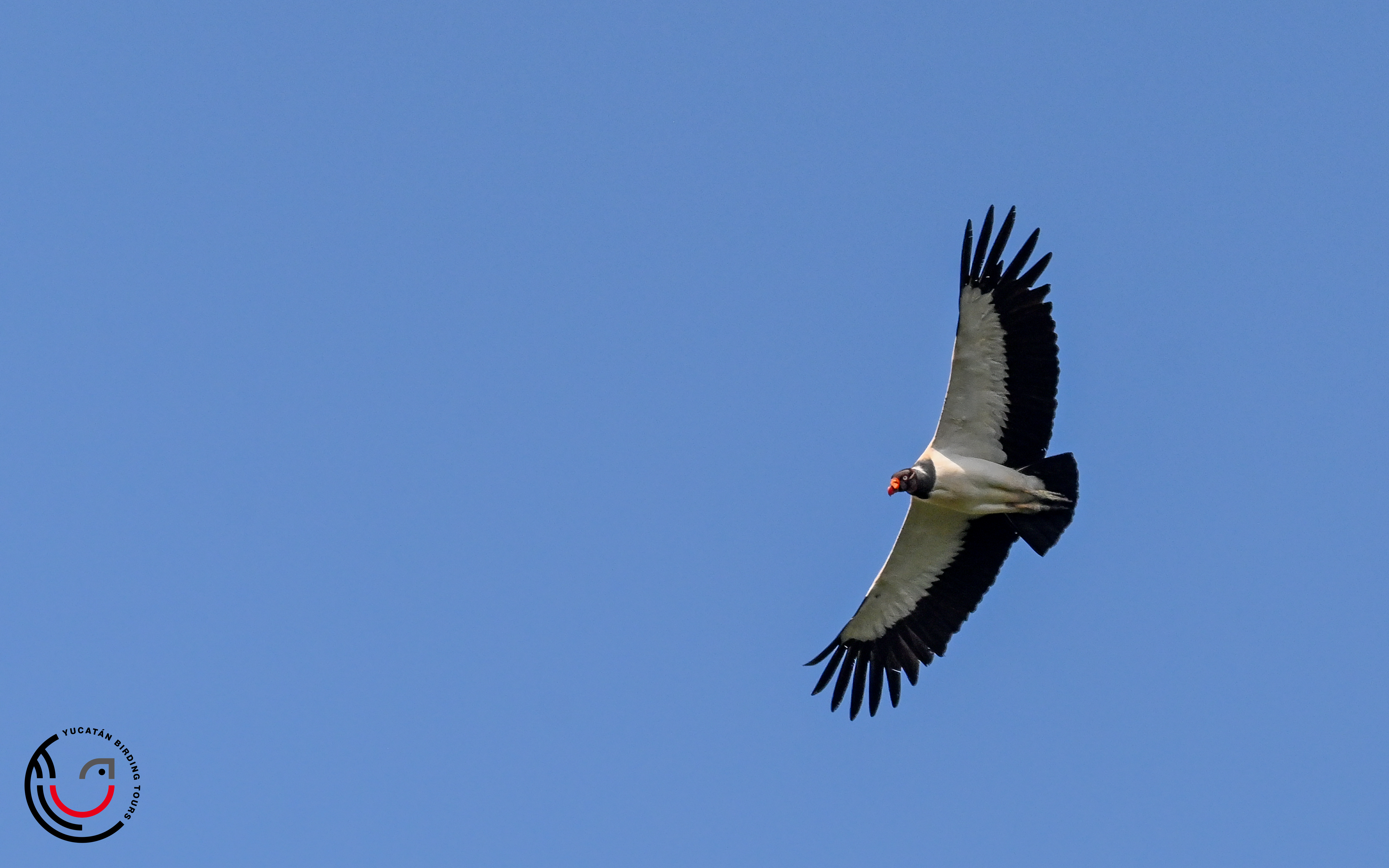
King Vulture (Sarcoramphus papa) near Felipe Carrillo Puerto.
During lunch, we also spotted a few birds like Couch’s Kingbird and Blue-gray Tanager.
After a nice meal, we drove all the way to Bacalar, where we were going to spend the night that day. Since we stayed in a place surrounded by the forest, we birded the hotel grounds in the evening, getting more than 30 species. Some highlights included: Plain Chachalaca, Squirrel Cuckoo, Buff-bellied Hummingbird, White-bellied Emerald, Black-headed Trogon, Golden-olive Woodpecker, Red-lored Amazon, Tawny-winged Woodcreeper, Eye-ringed Flatbill, Brown Jay, Spot-breasted Wren, Gray Catbird, Wood Thrush, Clay-colored Thrush, Yellow-billed Cacique, Worm-eating Warbler, American Redstart, Summer Tanager, Red-throat Ant-Tanager and Gray-headed Tanager.
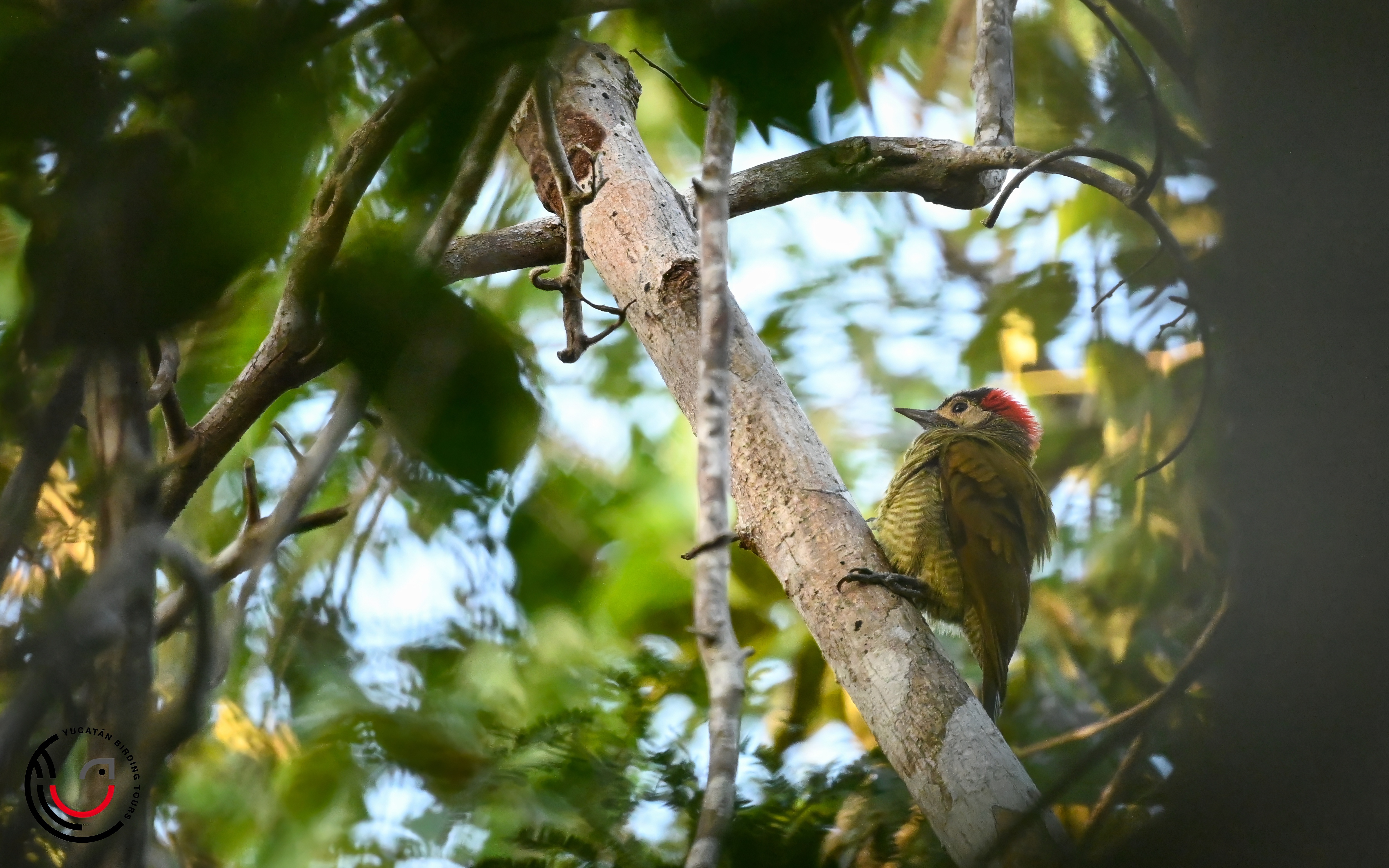
Golden-olive Woodpecker (Colaptes rubiginosus) at the hotel grounds.
DAY 4: THE KOHUNLICH ARCHAEOLOGICAL SITE.
For our last day birding together, we planned a visit to another one of our favorite birding spots, the Kohunlich Archaeological Site. This place, is very close to the border of the Yucatan Peninsula with Belize and Guatemala and has many birds that are present only around this area in the Yucatan. We birded the road outside the ruins first and spotted some really good species, including: Plain Chachalaca, Scaled Pigeon, Red-billed Pigeon, Rufous-tailed Hummingbird, Russet-naped Wood-Rail, American Pygmy Kingfisher, White-crowned Parrot, Ivory-billed Woodcreeper, White-collared Manakin, Bright-rumped Attila, Brown Jay, Green Jay, Spot-breasted Wren, Yellow-throated Euphonia, Yellow-billed Cacique, Summer Tanager, Red-throated Ant-Tanager, Rose-breasted Grosbeak, Blue Grosbeak, Red-legged Honeycreeper and Morelet’s Seedeater.
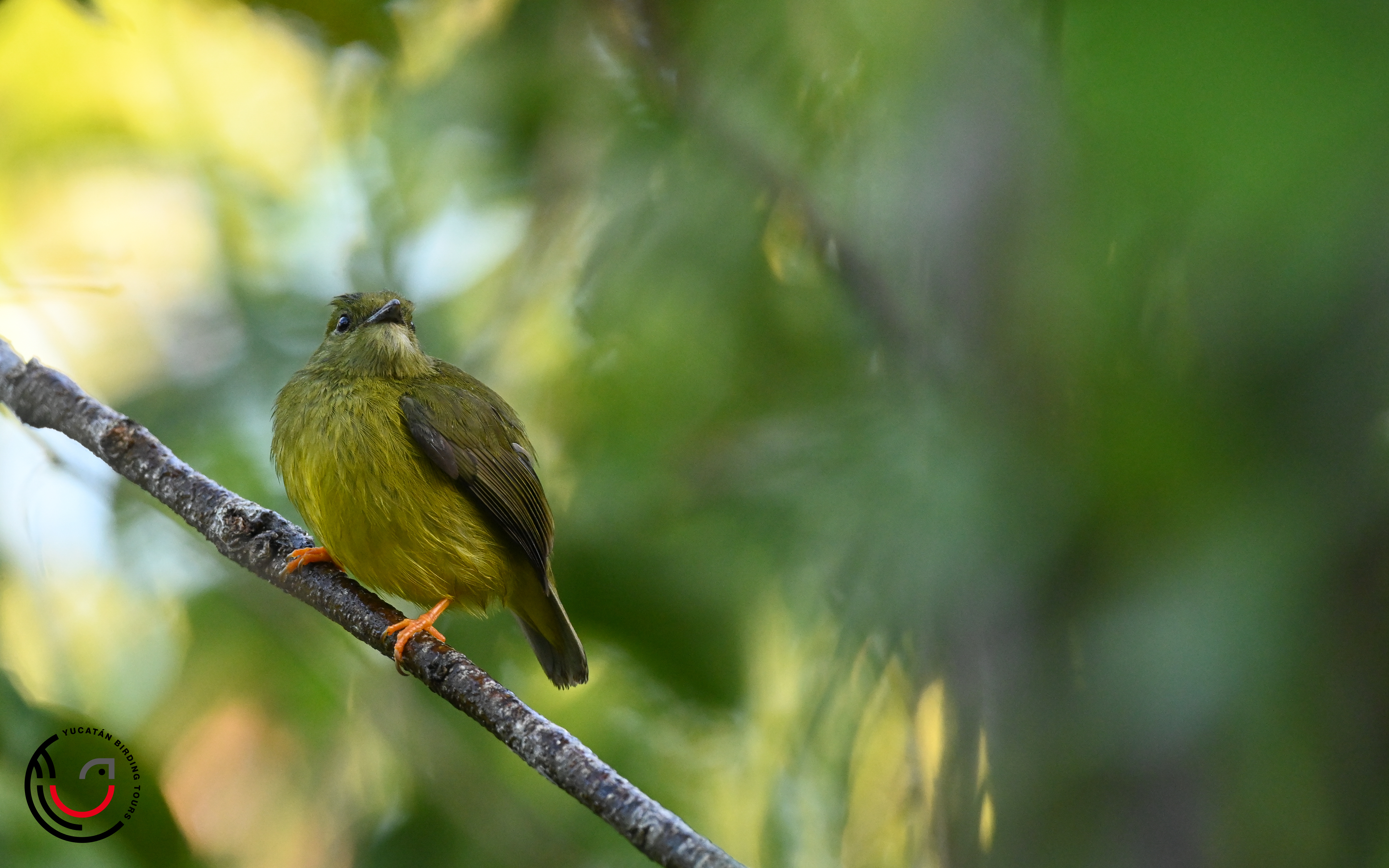
White-collared Manakin (Manacus candei) near the Kohunlich ruins.
After a good start, we went into the ruins for another two hours of birding and 40+ species! Highlights included: Squirrel Cuckoo, Rufous-tailed Hummingbird, White-bellied Emerald, Broad-winged Hawk (a rare species for the Yucatan Peninsula!), Black-headed Trogon, Pale-billed Woodpecker, Bat Falcon, White-crowned Parrot, Red-lored Amazon, Olivaceous Woodcreeper, Ivory-billed Woodcreeper, Ochre-bellied Flycatcher, Greenish Elaenia, Yellow-bellied Flycatcher, Great-crested Flycatcher, Lesser Greenlet, Spot-breasted Wren, White-breasted Wood-Wren, Yellow-throated Euphonia and Louisiana Waterthrush.

White-breasted Wood-Wren (Henicorhina leucosticta) at the Kohunlich Archaeological Site.
On the way out of the ruins, we also spotted a Hook-billed Kite, the last bird of the tour for us!
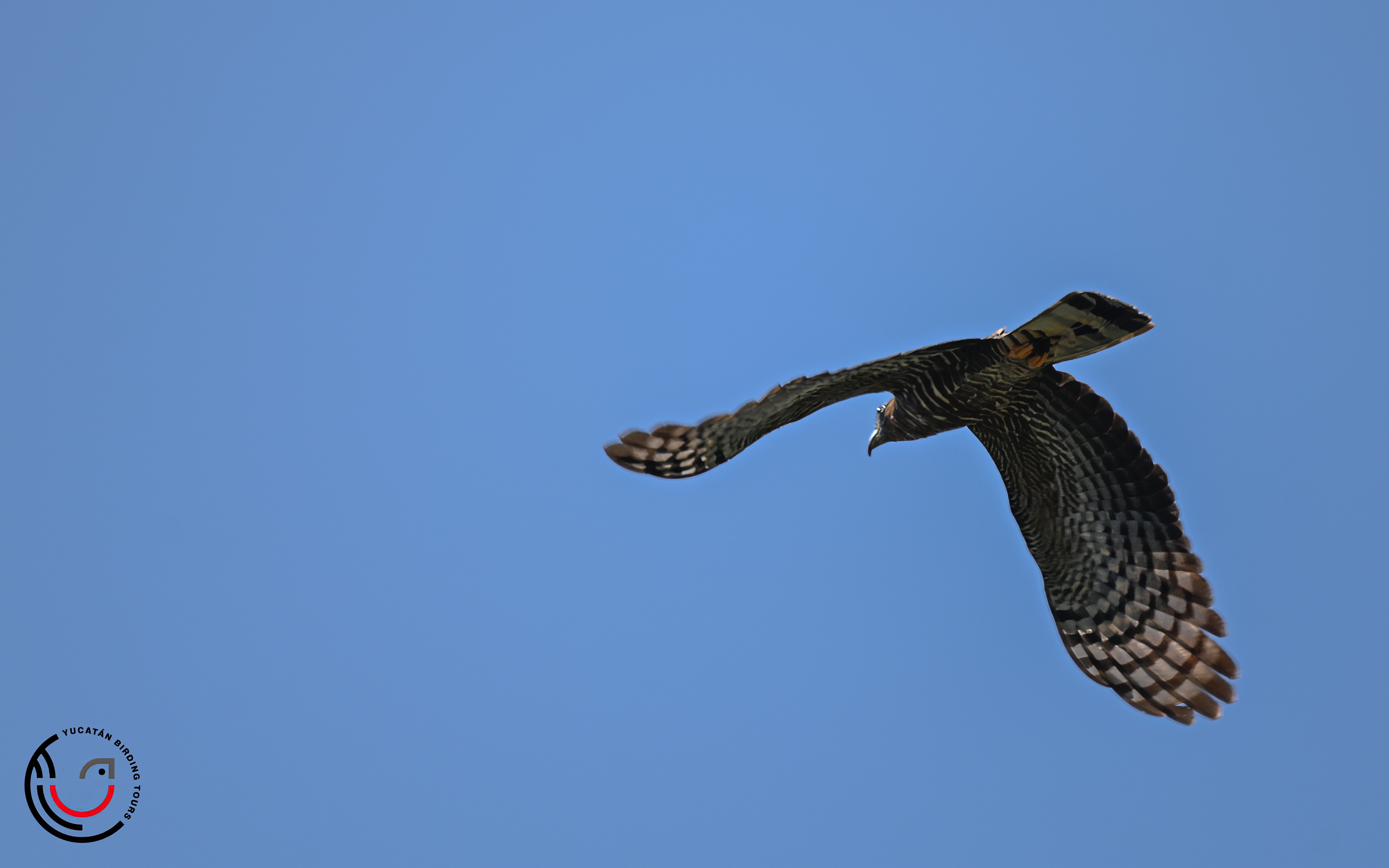
Hook-billed Kite (Chondrohierax uncinatus).
For the end of the trip, I dropped John and Rose in Bacalar as they were going to spend a few extra nights in the area and I drove back home to Mérida. We finished up the tour with a total of 186 bird species.
Written by Luis Trinchan Guerra.







